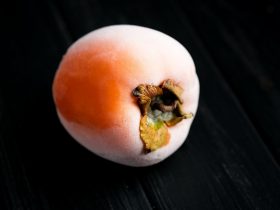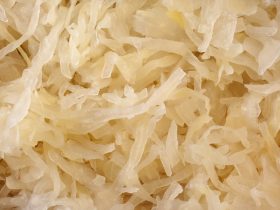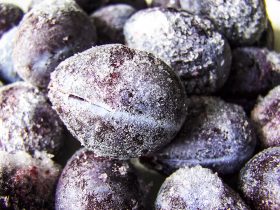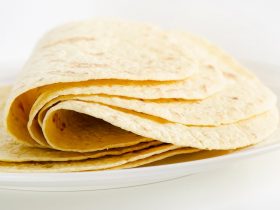Leeks, tangentially related to Garlic and Onions1, are edible leaves used for the sharp flavor that is characterized by the Allium plant family. Contrary to popular belief, the edible section of the plant is in fact not a stalk, but a set of leaves. Like all fresh produce, their room temperature shelf-life is a relatively short three to four days, however this can be extended with the proper care and methods.
In trials conducted by the U.S. Department of Agriculture, Leeks were found to last an approximate total of seven to fourteen days in a low-humidity environment of 35° – 40° F2. In the case of freezing leeks at a standard zero or subzero temperature freezer, the same studies have found that leeks will remain safe for consumption for at least twelve months, though certain procedures must be adhered to.
Can Leeks Be Frozen?
In short, yes, however, in assays conducted by the U.S. Department of Agriculture, leeks were found to contain 83g of water for every 100g of raw product3, meaning the rapid crystallization attributed to freezing could rupture the plant cell walls of the Leeks, affecting their texture but not their nutritional composition. The choice of whether the altered texture after freezing is acceptable is entirely an individual decision.
Required Equipment for Freezing
Through freezing leeks is relatively simple, it requires a source of potable water, a sharp knife, resealable plastic pouches for the leeks, a stove, a pot, a colander, and a freezer capable of zero or sub-zero temperatures.
Choosing Your Leeks
Leeks, once beyond their mature stage, begin to brown or yellow as natural decomposition takes place. Further signs of unsuitable leeks would be a dry, brittle texture to the leaves as well as off-color slime from the root. Additionally, any unusual smells should warrant an immediate disposal of the leeks. Ideally, purchasing or growing the freshest possible mature leeks would work best in the case of freezing them for future use.

While eating immature leeks is commonplace, the effects of freezing will dull the taste and texture of your produce somewhat. Knowing this, choose fully developed leeks with a dark green color and large leaves, as well as pale white shafts beneath said leaves, so as to retain their flavor and texture once thawed.
Freezing Whole Leeks: to Cut or Not to Cut
While it is possible to freeze leeks with no prior preparation, it is not recommended for the reason that leeks grow difficult to cut when frozen in their entirety, and take approximately one hour to thaw completely. Therefore, the proper procedure for immediately accessible leeks is to slice them in advance.
Preparing the Leeks for Freezing
As previously mentioned, freezing leeks in their entirety is a poor choice for any chef that wishes to have an immediately available batch of produce.
The first and immediate step after purchasing said leeks is to thoroughly rinse them, removing any traces of dirt or other waste matter attached to the root and to the leaves.
After carefully washing, dry the leaves either through evaporation or by patting them down with tissue paper. Once sufficiently dry, slice the leeks into thin rings, discarding the root or otherwise storing it for further uses. Cutting the plant into this shape will allow for easy and immediate thawing, as well as shape the leaves in such a way that they take up less space in your freezer once stored.
Once the sliced leaves are properly prepared, fill a bowl with a portion of ice water. Simultaneously, fill a cooking pot with enough water to submerge the leek leaves, and heat until the water is boiling. After achieving boiling temperature, using a colander or similar kitchen device, place the leeks in the boiling water for approximately one minute, paying careful attention to not over-blanch them. Remove the leeks from the boiling water and submerge them in the previously prepared ice water, rapidly cooling the leaves. Repeat the same drying procedure as before.
Freezing the Leeks
After cutting and treating the leeks, place them into a resealable plastic pouch, ensuring they are evenly distributed throughout the bag. Compress the bag carefully, so as to remove any excess air, and seal it.
Situate the leeks in the freezer and ascertain that they will not be placed beneath any other objects in your freezer, as placing further pressure on the frozen leeks will ruin their texture even more.
Thawing the Leeks
In the event that you choose to use your frozen leeks, simply remove the amount you wish to use from the freezer and place them anywhere at room temperature. Do not attempt to defrost your leeks in the microwave.
Re-freezing the Leeks
Refreezing of your leeks is not recommended as each subsequent thawing and refreezing introduces further and further damage to the cells of the plant, rupturing the cell walls and therefore affecting the flavor and texture.
Ensure that, once your leeks are frozen, only the required amount is removed from the bag and defrosted, so as to minimize waste and retain the leek’s texture and taste.
Is Blanching the Leaves Optional?
While it is entirely possible to freeze your sliced leeks without the need for boiling and rapidly cooling them, blanching vegetables allows the produce to remain stable and safe to eat for longer periods of time, owing to the interruption of bacterial and enzymatic action from the rapidly changing temperature extremes.4
Things to Keep in Mind
While freezing leeks saves time and energy, it is important to remember that fresh produce is the ideal choice for creating a dish. Freezing the leeks will sap a portion of the flavor and crisp texture, affecting the impact they will have on your cooking.
Frozen leeks are best used in cooked dishes, as using them for garnishing or toppings may provide an unpleasant temperature difference.
References
1. Block, E. (2010). Garlic and Other Alliums: The Lore and the Science. Royal Society of Chemistry
2. https://www.fsis.usda.gov/science-data
3. https://fdc.nal.usda.gov/fdc-app.html#/food-details/169246/nutrients
4. University of Minnesota Extension; So Easy to Preserve, 2014, 6th Edition, University of Georgia; Ohio State University, 2020





Hi, I'm Dom
Dom Eats was started to help other people fall in love with food. While cooking can feel intimidating, it doesn't have to be.